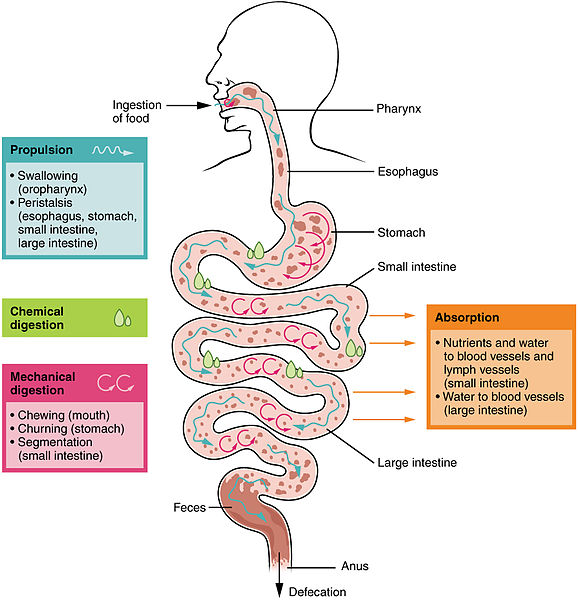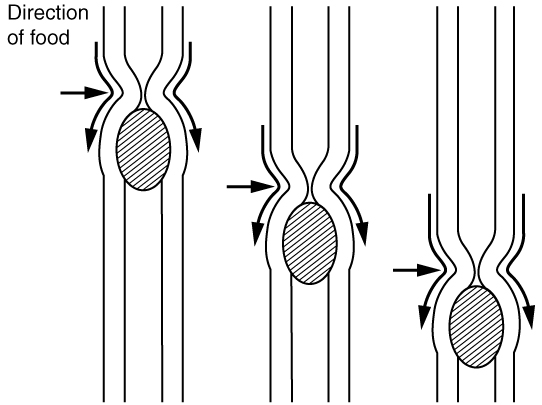12.5 Physiology of the Digestive System
Functions of the Digestive System
The main functions of the digestive system are ingesting food, digesting food, absorbing nutrients, and eliminating waste products. See Table 12.5 for an overview of the functions of the organs of the digestive tract.
Table 12.5. Functions of the Digestive Organs[1]
| Organ | Major Functions | Other Functions |
|---|---|---|
| Mouth |
|
|
| Pharynx |
|
|
| Esophagus |
|
|
| Stomach |
|
|
| Small Intestine |
|
|
| Large Intestine |
|
|
| Accessory Organs |
|
|
Digestive Processes
Digestive processes involve the interaction of several organs and occur gradually as food moves through the gastrointestinal tract. The processes of digestion include six activities: ingestion, propulsion, mechanical digestion, chemical digestion, absorption, and defecation.[2] See Figure 12.13[3] for an illustration of digestive processes.

Ingestion
Ingestion refers to the intake of food through the mouth where it is chewed and mixed with saliva. Saliva contains enzymes that begin breaking down the carbohydrates and fats in the food. Chewing produces a soft mass of food called a bolus (BŌL-ŭs) that is an appropriate size for swallowing.[4]
Propulsion
Food leaves the mouth when the tongue and pharyngeal muscles propel it into the esophagus. This act of swallowing is an example of propulsion, which refers to the movement of food through the digestive tract. It includes both the voluntary process of swallowing and the involuntary process of peristalsis (per-ĭ-STAL-sĭs). Peristalsis consists of sequential, alternating waves of contraction and relaxation of smooth muscles, which act to propel food through the digestive tract. See Figure 12.14[5] for an illustration of peristalsis. Peristaltic waves also play a role in mixing food with digestive juices. Peristalsis is so powerful that swallowed foods and liquids enter the stomach even if you are standing on your head.[6]

Mechanical Digestion
Mechanical digestion is a physical process that does not change the chemical nature of the food but makes it smaller to increase its surface area and mobility. Mechanical digestion starts with chewing and then progresses to mechanical churning of food in the stomach. In the stomach, the bolus of food further breaks apart with more surface area that is exposed to digestive juices of chemical digestion.[7]
Chemical Digestion
Chemical digestion begins in the mouth and is completed in the small intestine. Digestive secretions contain water, enzymes (EN-zīmz), acids, and salts that create an acidic “soup” that breaks down food molecules into their chemical building blocks. For example, proteins are broken down into amino acids (Ā-mē-nō AS-idz).[8]
Absorption
Nutrients (NŪ-trē-ĕntz) are substances that provide nourishment to cells. After food molecules have been broken down during chemical digestion, nutrients enter the bloodstream through the process of absorption (ab-SORP-shŏn). Absorption takes place primarily in the small intestine.
Defecation
During defecation (dĕf-ĕ-KĀ-shŏn), the final step in digestion, undigested materials are expelled from the body as feces.[9]
Additional Terms Related to the Digestive System
Additional common medical terms related to the digestive system include the following:
- Adhesion (ad-HĒ-zhŏn): Scar tissue from disease or previous surgery that binds anatomic surfaces to each other.
- Ascites (ă-SĪ-tēz): Abnormal fluid buildup in the abdominal cavity.
- Dysentery (DIS-ĕn-ter-ē): Inflammation of the intestine presenting with abdominal pain and bloody diarrhea.
- Dyspepsia (dĭs-PEP-sē-ă): Indigestion.
- Emesis (ĔM-ĕ-sĭs): Vomiting
- Flatus (FLĀ-tŭs): Gas in the GI tract.
- Gastroenteritis (GAS-trō-ĕn-tĕr-Ī-tĭs): Inflammation of the stomach and intestines.
- Hernia (HUR-nē-ă): Protrusion of an organ through a muscular wall.
- Melena (mĕ-LĒ-nă): Black, tarry feces that contains blood from the digestive tract.
- Nausea (NAW-zē-ă): The feeling of an urge to vomit.
- NPO (en-pee-ō): A commonly used medical abbreviation standing for “nothing by mouth,” meaning not to ingest food, fluids, or medications orally.
- Obesity (ō-BĒ-sĭ-tē): Increased proportion of fat cells, resulting in excessive body weight in proportion to height.
- Palpate (PAL-pāt): A physical examination technique where the examiner feels for texture, size, consistency, and location of organs with their hands.
- Percutaneous endoscopic gastrostomy (pûr-kū-TĀ-nē-ŭs ĕn-DŎS-kŏ-pĭk găs-TRŎS-tŏ-mē) (PEG): A surgical procedure that places a feeding tube into the stomach through the abdominal wall to administer nutrition when swallowing is impaired.
- Probiotics (prō-bī-OT-ĭks): Normally occurring bacteria that are beneficial for digestion.
- Reflux (RĒ-flŭks): Abnormal backward flow.
- Visceral (VĬS-ĕr-ăl): Relating to the organs.
- Vomiting (VOM-ĭ-ting): Forceful ejection of stomach contents.
- This work is a derivative of Anatomy & Physiology by OpenStax and is licensed under CC BY 4.0. Access for free at https://openstax.org/details/books/anatomy-and-physiology-2e ↵
- This work is a derivative of Anatomy and Physiology by OpenStax licensed under CC BY 4.0. Access for free at https://openstax.org/books/anatomy-and-physiology/pages/1-introduction ↵
- “2405_Digestive_Process.jpg” by OpenStax College is licensed under CC BY 3.0 ↵
- This work is a derivative of Anatomy and Physiology by OpenStax licensed under CC BY 4.0. Access for free at https://openstax.org/books/anatomy-and-physiology/pages/1-introduction ↵
- “2404_PeristalsisN.jpg” by OpenStax College is licensed under CC BY 3.0 ↵
- This work is a derivative of Anatomy and Physiology by OpenStax licensed under CC BY 4.0. Access for free at https://openstax.org/books/anatomy-and-physiology/pages/1-introduction ↵
- This work is a derivative of Anatomy and Physiology by OpenStax licensed under CC BY 4.0. Access for free at https://openstax.org/books/anatomy-and-physiology/pages/1-introduction ↵
- This work is a derivative of Anatomy and Physiology by OpenStax licensed under CC BY 4.0. Access for free at https://openstax.org/books/anatomy-and-physiology/pages/1-introduction ↵
- This work is a derivative of Anatomy and Physiology by OpenStax licensed under CC BY 4.0. Access for free at https://openstax.org/books/anatomy-and-physiology/pages/1-introduction ↵

